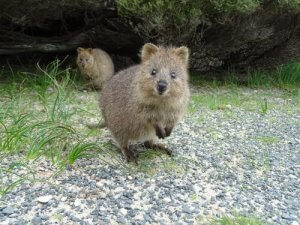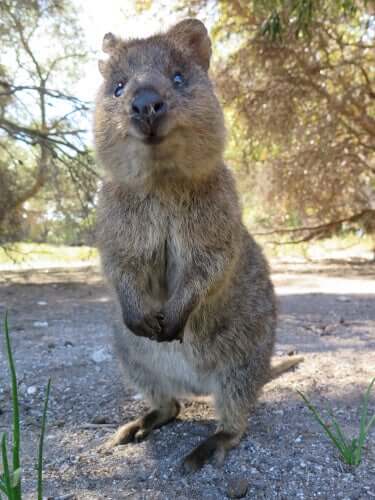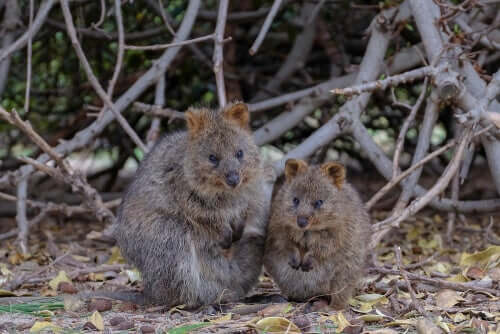Meet the Quokka: The Happiest Animal in the World

The quokka has earned the title of “the happiest animal in the world” thanks to the constant smile on its face. With this recent fame, lots of people are wondering what exactly this animal is.
The quokka is a marsupial
This tiny kangaroo has the scientific name of Setonix Brachyurus. It’s a type of marsupial in the Macropodiae family and the Diprotodontia order.
Animals in that order are all marsupials from the Oceania region of the world. There’s a huge variety of species within the order, too. You’ve probably heard of at least a few of them, like the kangaroo, the koala, the cuscus, and the tiny pygmy possum.
One of the defining characteristics of this order of animal species is the two forward-facing incisors in their mouth. Plus, if you factor in the fact that they go all the way back to the Oligocene epoch (over 23 million years ago), you can see that they’ve evolved to adapt to many changes. That’s also why there are so many different species.
The history of the quokka
The first written record we have of the quokka comes from the year 1658. Someone described it as “similar to a Civet cat, but brown.” Only a few decades later, yet another person spotted one and described it as “a kind of rat as big as a cat.”
Though we now call them quokkas, aboriginal peoples had many different names for them. There are too many to mention them all here, but two examples are quak-a and kwoka. These were obviously were we took the English word from.

In terms of classification, they belong to the Setonix genus. That word comes from the Latin, where “seta” basically means sow, and “onix” means claw. The “brachyurus” part we mentioned above comes from the Greek, though. It comes from “brachys” (short), “and “oura” (tail).
Experts believe that quokkas only branched off from other wallabies in the Macropus genus quite recently. They don’t have many traits in common, and that’s why a separate species was created to classify them.
General characteristics
Quokkas are small, about the same size as a house cat. They have short, thick grayish-brown fur, with some patches of lighter colors. Their noses have no hair around them, and they have small ears. Their long tails, however, can be anywhere from 4 to 12 inches long.
In terms of body weight, they generally weigh anywhere from 6-9 pounds. As for their height (head included), they’re about 16-21 inches tall. Their back feet can also grow to nearly 5 inches long.
There is some degree of sexual dimorphism in this species. In this case, the males tend to be a bit taller and heavier than females. Males are, on average, about half an inch taller, and about 2 pounds heavier.

When it comes to eating habits, the quokka is primarily an herbivore. Leaves and stems are two of their favorite foods, though their diet can vary a lot depending on the region they’re in, and what season it is.
We should also mention that the quokka is a nocturnal animal that lives in Eastern Australia. More specifically, they’re native to the southeast part of the country, including Rottness and Bald islands. As of right now, we have no reason to believe there are any subspecies of them.
In terms of their life expectancy, quokkas tend to live to about 10 in the wild. In captivity, they can make it to up to 14 years.
Conservation
In 1996, the quokka was included on the list of “fauna that is rare or near extinction.” There were several different reasons for its inclusion. For one thing, their habitat has shrunk a lot, and is continuing to do so. The quokka population has also been dwindling year after year, and they still have many natural predators.
That loss of habitat and the scarcity of food that comes with that are major issues. Experts have found localized extinctions in certain forests due to their being no food there that the quokkas could eat.
In 2013, Australia initiated a plan to help the species recover. It addresses several of these risk factors. That means it deals with everything from predators such as foxes and wild cats, to climate change, along with the loss of habitat and all kinds of different illnesses.
For now, it looks like their numbers are still going down. We estimate that there are about 7,500-15,000 mature adults alive right now. The IUCN has also classified the quokka as a “vulnerable species.”
In spite of all these hardships, the quokka always has a smile on its face. Plus, it’s just as willing to give out its smiles as it is to receive them.
The quokka has earned the title of “the happiest animal in the world” thanks to the constant smile on its face. With this recent fame, lots of people are wondering what exactly this animal is.
The quokka is a marsupial
This tiny kangaroo has the scientific name of Setonix Brachyurus. It’s a type of marsupial in the Macropodiae family and the Diprotodontia order.
Animals in that order are all marsupials from the Oceania region of the world. There’s a huge variety of species within the order, too. You’ve probably heard of at least a few of them, like the kangaroo, the koala, the cuscus, and the tiny pygmy possum.
One of the defining characteristics of this order of animal species is the two forward-facing incisors in their mouth. Plus, if you factor in the fact that they go all the way back to the Oligocene epoch (over 23 million years ago), you can see that they’ve evolved to adapt to many changes. That’s also why there are so many different species.
The history of the quokka
The first written record we have of the quokka comes from the year 1658. Someone described it as “similar to a Civet cat, but brown.” Only a few decades later, yet another person spotted one and described it as “a kind of rat as big as a cat.”
Though we now call them quokkas, aboriginal peoples had many different names for them. There are too many to mention them all here, but two examples are quak-a and kwoka. These were obviously were we took the English word from.

In terms of classification, they belong to the Setonix genus. That word comes from the Latin, where “seta” basically means sow, and “onix” means claw. The “brachyurus” part we mentioned above comes from the Greek, though. It comes from “brachys” (short), “and “oura” (tail).
Experts believe that quokkas only branched off from other wallabies in the Macropus genus quite recently. They don’t have many traits in common, and that’s why a separate species was created to classify them.
General characteristics
Quokkas are small, about the same size as a house cat. They have short, thick grayish-brown fur, with some patches of lighter colors. Their noses have no hair around them, and they have small ears. Their long tails, however, can be anywhere from 4 to 12 inches long.
In terms of body weight, they generally weigh anywhere from 6-9 pounds. As for their height (head included), they’re about 16-21 inches tall. Their back feet can also grow to nearly 5 inches long.
There is some degree of sexual dimorphism in this species. In this case, the males tend to be a bit taller and heavier than females. Males are, on average, about half an inch taller, and about 2 pounds heavier.

When it comes to eating habits, the quokka is primarily an herbivore. Leaves and stems are two of their favorite foods, though their diet can vary a lot depending on the region they’re in, and what season it is.
We should also mention that the quokka is a nocturnal animal that lives in Eastern Australia. More specifically, they’re native to the southeast part of the country, including Rottness and Bald islands. As of right now, we have no reason to believe there are any subspecies of them.
In terms of their life expectancy, quokkas tend to live to about 10 in the wild. In captivity, they can make it to up to 14 years.
Conservation
In 1996, the quokka was included on the list of “fauna that is rare or near extinction.” There were several different reasons for its inclusion. For one thing, their habitat has shrunk a lot, and is continuing to do so. The quokka population has also been dwindling year after year, and they still have many natural predators.
That loss of habitat and the scarcity of food that comes with that are major issues. Experts have found localized extinctions in certain forests due to their being no food there that the quokkas could eat.
In 2013, Australia initiated a plan to help the species recover. It addresses several of these risk factors. That means it deals with everything from predators such as foxes and wild cats, to climate change, along with the loss of habitat and all kinds of different illnesses.
For now, it looks like their numbers are still going down. We estimate that there are about 7,500-15,000 mature adults alive right now. The IUCN has also classified the quokka as a “vulnerable species.”
In spite of all these hardships, the quokka always has a smile on its face. Plus, it’s just as willing to give out its smiles as it is to receive them.
All cited sources were thoroughly reviewed by our team to ensure their quality, reliability, currency, and validity. The bibliography of this article was considered reliable and of academic or scientific accuracy.
-
Goverment of Western Australia. Department od Environment and Conservation. Quokka (Setonyx brachyurus) [Internet]. Western Australia; 2013 ene p. 39. Report No.: 56. Disponible en: https://www.environment.gov.au/system/files/resources/4581df81-0041-4fc9-ba1b-aca7cb22246d/files/quokka-recovery-plan.pdf
-
The IUCN Red List of Threatened Species [Internet]. IUCN Red List of Threatened Species. [citado 2 de septiembre de 2019]. Disponible en: https://www.iucnredlist.org/en
- Setonix brachyurus. En: Wikipedia, la enciclopedia libre [Internet]. 2019 [citado 2 de septiembre de 2019]. Disponible en: https://es.wikipedia.org/w/index.php?title=Setonix_brachyurus&oldid=118151007
This text is provided for informational purposes only and does not replace consultation with a professional. If in doubt, consult your specialist.








